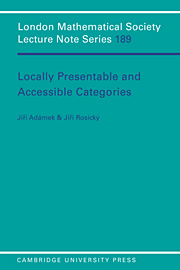4 - Injectivity Classes
Published online by Cambridge University Press: 15 December 2009
Summary
In the present chapter we study two special classes of accessible categories: weakly locally presentable categories, which are the accessible categories with products, and locally multipresentable categories, which are the accessible categories with connected limits. Recall that locally presentable categories can be characterized by orthogonality (in the sense that they are just the small-orthogonality classes in categories SetA, see Theorem 1.46). We will show that weakly locally presentable categories can be characterized by injectivity (Theorem 4.11), and locally multipresentable categories by cone-orthogonality (Theorem 4.30). And, while locally presentable categories are precisely the categories sketchable by limit-sketches, weakly locally presentable categories are sketchable by limit–epi sketches (i.e., sketches whose models are set-valued functors preserving certain limits and certain epimorphisms) (Theorem 4.13), and locally multipresentable categories are sketchable by limit–coproduct sketches (i.e., models preserve certain limits and certain products) (Theorem 4.32).
Orthogonality w.r.t. a morphism can be generalized to orthogonality (or injectivity) w.r.t. a cone as follows: an object K is orthogonal if every morphism from the domain of the cone to K has a unique factorization through a unique member of the cone. (And K is injective if every morphism from the domain of the cone to K has a factorization through some member.) Accessible categories are then described as precisely the categories of objects injective w.r.t. a set of cones in some locally presentable category (Corollary 4.18). (This is closely related to the characterization of accessible categories as cone-reflective subcategories of the categories SetA, see Corollary 2.54.) Locally multipresentable categories are described as precisely the categories of objects orthogonal w.r.t. a set of cones in a locally presentable category (Theorem 4.30).
- Type
- Chapter
- Information
- Locally Presentable and Accessible Categories , pp. 173 - 198Publisher: Cambridge University PressPrint publication year: 1994

